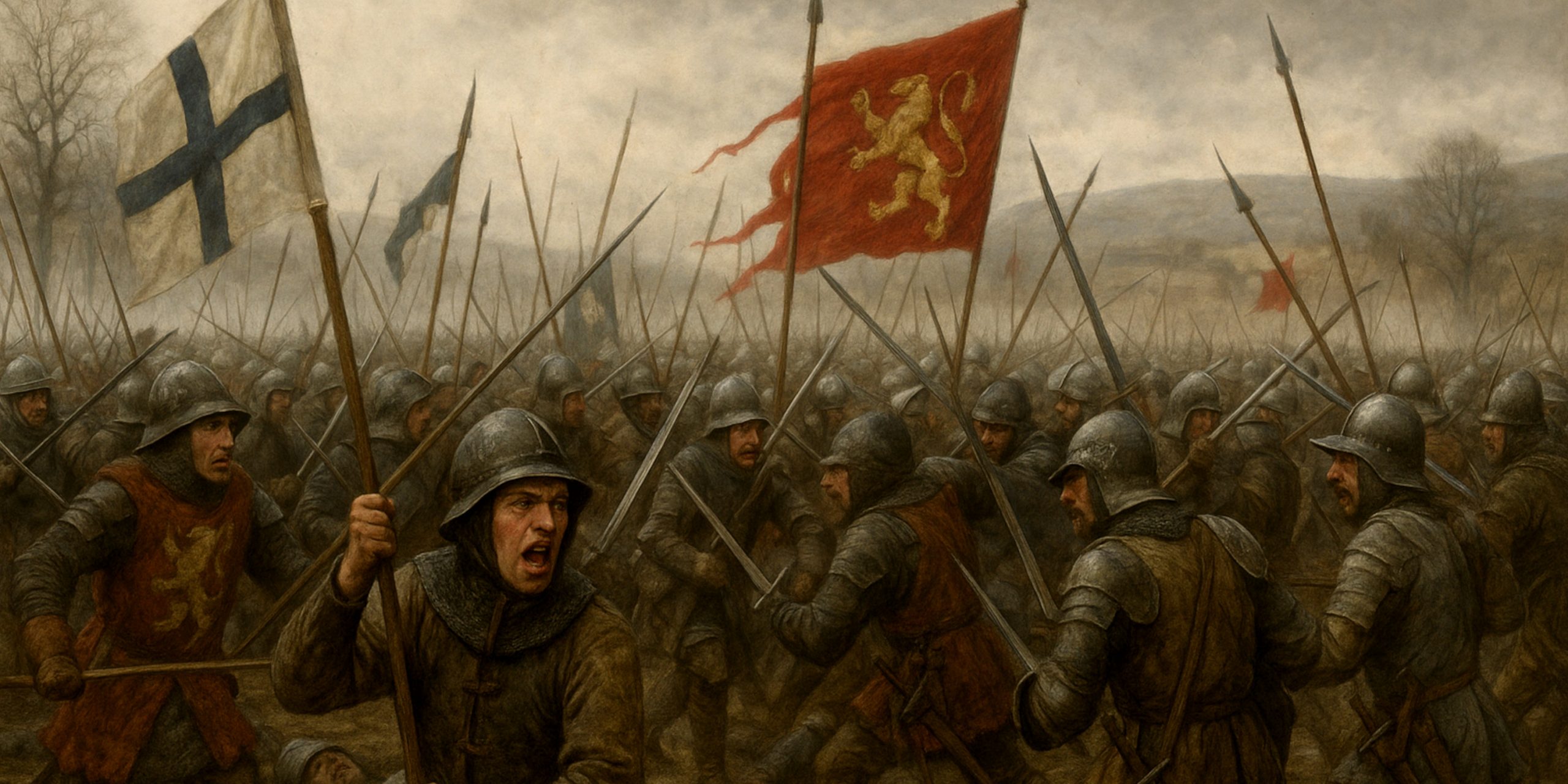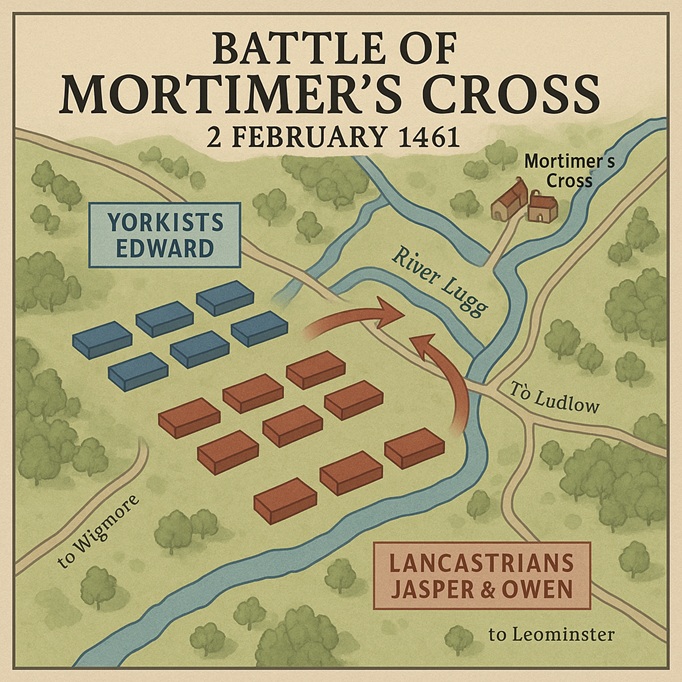
The Battle of Mortimer’s Cross took place near Wigmore in Herefordshire on 2 February 1461, during a critical phase of the Wars of the Roses. It was a decisive Yorkist victory that solidified Edward, Earl of March’s position following the death of his father, Richard, Duke of York, at Wakefield the previous December.
The battle is notable for its smaller scale compared to Towton or Barnet, yet it had outsized consequences. It was Edward’s first independent command and marked the emergence of his military authority, setting the stage for his eventual claim to the throne as Edward IV.
Forces
| Faction | Estimated Troops | Notable Commanders |
|---|---|---|
| Yorkist | 5,000–8,000 | Edward, Earl of March (later Edward IV) |
| Lancastrian | 6,000–10,000 | Owen Tudor, Jasper Tudor, James Butler (Earl of Wiltshire) |
The Yorkist army was likely outnumbered but better positioned and led. Local levies and retainers from the Welsh Marches reinforced Edward’s force. The Lancastrians were retreating after failing to unite with the Queen’s army in the north.
Leaders and Troop Composition
Yorkist Side:
- Edward, Earl of March: 18 years old but commanding with confidence. Took the initiative to block the Lancastrian advance through the Marches.
- Sir William Herbert and Sir Walter Devereux: Key Marcher Lords and Edward’s supporters.
- Troops were primarily composed of:
- Marcher retainers with knowledge of local terrain.
- A small contingent of dismounted men-at-arms.
- Longbowmen and billmen common in English retinues.
Lancastrian Side:
- Owen Tudor: Henry VI’s stepfather. Captured and executed after the battle.
- Jasper Tudor: Earl of Pembroke, fled the battlefield.
- James Butler, Earl of Wiltshire: Fled the battle and was later ridiculed for cowardice.
- Troops included:
- Welsh recruits with limited battle experience.
- Irish mercenaries under Wiltshire’s command.
- A mixture of archers and light infantry, with some cavalry under Wiltshire.
Arms and Armour
- Yorkist Forces:
- Wore typical 15th-century English armour: brigandines, mail shirts, bascinets or sallets with visors.
- Archers used the English longbow, effective at range.
- Billhooks and poleaxes were common in close combat.
- Lancastrian Forces:
- Mixed equipment levels, especially among Irish and Welsh troops.
- Fewer heavy infantry, with more reliance on lighter arms.
- Longbows used less effectively due to tactical positioning.
Both sides used banners and standards to signal during the engagement, with the Yorkist sunburst symbol reportedly prominent—a reference to the parhelion phenomenon seen that morning, interpreted by Edward’s men as a divine sign.
Timeline of the Battle

| Time | Event |
|---|---|
| Early Morning | Parhelion sighting interpreted by Edward as a positive omen. |
| Late Morning | Yorkists take position near Mortimer’s Cross, blocking road to Wigmore. |
| Midday | Lancastrians advance but are slowed by narrow approach routes. |
| Afternoon | Fierce hand-to-hand combat. Wiltshire flees early in the engagement. |
| Late Afternoon | Owen Tudor captured while retreating, others scatter or are slain. |
Edward’s tactical discipline and use of terrain gave him a crucial edge. The Lancastrians were compressed into a disadvantageous formation and could not effectively deploy their numbers.
Archaeology
Mortimer’s Cross remains one of the less excavated battlefields of the Wars of the Roses. The exact location is still debated, though most agree it occurred near the River Lugg close to Kingsland. Limited metal detecting surveys have uncovered:
- Arrowheads consistent with longbow use.
- Belt mounts and strap-ends.
- Some iron weapon fragments, possibly from billhooks.
No mass grave has been confirmed, but local tradition points to burial pits at or near Chapel Hill.
Contemporary Quotes
- Gregory’s Chronicle (anonymous London chronicler): “And there was slayne at that batayle, by the mene of Edwarde Erle of Marche, a grete multitude of Walshemen…”
- The Arrivall of Edward IV (pro-Yorkist chronicle): “The Erle of Marche was grete and hye of stature, and therfore he was lyghtly knowen in the batayll, and manly he bare hymself.”
These sources reflect both the brutality of the clash and Edward’s emerging reputation as a forceful leader.
Legacy
The Battle of Mortimer’s Cross helped Edward secure the west of England and gave him the credibility he needed to later claim the crown. It also severely weakened Lancastrian support in Wales.
Owen Tudor’s capture and beheading at Hereford Bridge was a symbolic blow, especially for the legitimacy of Henry VI’s court. Meanwhile, the battle helped forge Edward’s image as a warrior-king—young, commanding, and victorious under a sign from the heavens.
Though not the largest battle of the period, Mortimer’s Cross remains a pivotal moment in the civil war’s trajectory, reinforcing the idea that personal leadership could overcome numerical disadvantage.
Watch the documentary:



